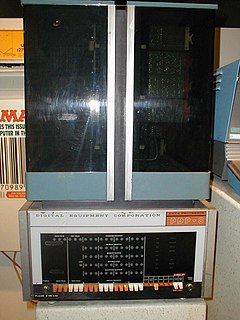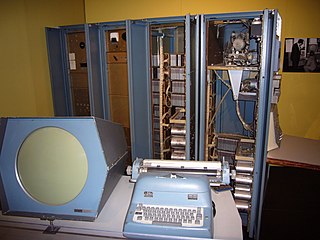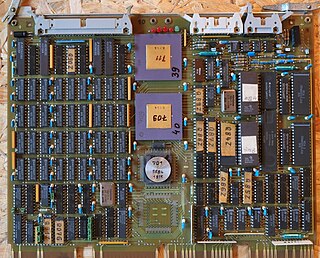Related Research Articles

Digital Equipment Corporation, using the trademark Digital, was a major American company in the computer industry from the 1960s to the 1990s. The company was co-founded by Ken Olsen and Harlan Anderson in 1957. Olsen was president until forced to resign in 1992, after the company had gone into precipitous decline.

A minicomputer, or colloquially mini, is a class of smaller general purpose computers that developed in the mid-1960s and sold for much less than mainframe and mid-size computers from IBM and its direct competitors. In a 1970 survey, The New York Times suggested a consensus definition of a minicomputer as a machine costing less than US$25,000, with an input-output device such as a teleprinter and at least four thousand words of memory, that is capable of running programs in a higher level language, such as Fortran or BASIC.

Programmed Data Processor (PDP), referred to by some customers, media and authors as "Programmable Data Processor," is a term used by the Digital Equipment Corporation from 1957 to 1990 for several lines of minicomputers.

The PDP-11 is a series of 16-bit minicomputers sold by Digital Equipment Corporation (DEC) from 1970 into the 1990s, one of a set of products in the Programmed Data Processor (PDP) series. In total, around 600,000 PDP-11s of all models were sold, making it one of DEC's most successful product lines. The PDP-11 is considered by some experts to be the most popular minicomputer.

VAX is a series of computers featuring a 32-bit instruction set architecture (ISA) and virtual memory that was developed and sold by Digital Equipment Corporation (DEC) in the late 20th century. The VAX-11/780, introduced October 25, 1977, was the first of a range of popular and influential computers implementing the VAX ISA. The VAX family was a huge success for DEC - over 100 models were introduced over the lifetime of the design, with the last members arriving in the early 1990s. The VAX was succeeded by the DEC Alpha, which included several features from VAX machines to make porting from the VAX easier.

RSX-11 is a discontinued family of multi-user real-time operating systems for PDP-11 computers created by Digital Equipment Corporation. In widespread use through the late 1970s and early 1980s, RSX-11 was influential in the development of later operating systems such as VMS and Windows NT.
RT-11 is a discontinued small, low-end, single-user real-time operating system for the full line of Digital Equipment Corporation PDP-11 16-bit computers. RT-11 was first implemented in 1970. It was widely used for real-time computing systems, process control, and data acquisition across all PDP-11s. It was also used for low-cost general-use computing.

Chester Gordon Bell is an American electrical engineer and manager. An early employee of Digital Equipment Corporation (DEC) 1960–1966, Bell designed several of their PDP machines and later became Vice President of Engineering 1972–1983, overseeing the development of the VAX. Bell's later career includes entrepreneur, investor, founding Assistant Director of NSF's Computing and Information Science and Engineering Directorate 1986–1987, and researcher emeritus at Microsoft Research, 1995–2015.

The history of computing hardware in the Soviet Bloc is somewhat different from that of the Western world. As a result of the CoCom embargo, computers could not be imported on a large scale from Western Bloc.
The SM-4 (CM-4) was a PDP-11/40 compatible system, manufactured in the Eastern Bloc in the 1980s. It was very popular in science and technology. They were manufactured in the Soviet Union, Bulgaria and Hungary, beginning in 1975.
SM EVM was the general name for several types of Soviet and Comecon minicomputers produced in the 1970s and 1980s. Production began in 1975.
Mobile Operating System is an operating system, a Soviet clone of Unix from the 1980s.
The BUNCH was the nickname for the group of mainframe computer competitors of IBM in the 1970s. The name is derived from the names of the five companies: Burroughs, UNIVAC, NCR, Control Data Corporation (CDC), and Honeywell. These companies were grouped together because the market share of IBM was much higher than all of its competitors put together.

The Professional 325 (PRO-325), Professional 350 (PRO-350), and Professional 380 (PRO-380) were PDP-11 compatible microcomputers introduced in 1982 by Digital Equipment Corporation (DEC) as high-end competitors to the IBM PC.

Am2900 is a family of integrated circuits (ICs) created in 1975 by Advanced Micro Devices (AMD). They were constructed with bipolar devices, in a bit-slice topology, and were designed to be used as modular components each representing a different aspect of a computer control unit (CCU). By using the bit slicing technique, the Am2900 family was able to implement a CCU with data, addresses, and instructions to be any multiple of 4 bits by multiplying the number of ICs. One major problem with this modular technique was that it required a larger number of ICs to implement what could be done on a single CPU IC. The Am2901 chip was the arithmetic-logic unit (ALU), and the "core" of the series. It could count using 4 bits and implement binary operations as well as various bit-shifting operations.

The K 1820, full name RVS K 1820, cipher in the SM EVM of the former COMECON countries SM 1720, was a workstation developed in East Germany. VEB Robotron Elektronik Dresden began development of the K 1820 in 1986 and it went into serial production in 1990.
Mainframe computers are computers used primarily by businesses and academic institutions for large-scale processes. Before personal computers, first termed microcomputers, became widely available to the general public in the 1970s, the computing industry was composed of mainframe computers and the relatively smaller and cheaper minicomputer variant. During the mid to late 1960s, many early video games were programmed on these computers. Developed prior to the rise of the commercial video game industry in the early 1970s, these early mainframe games were generally written by students or employees at large corporations in a machine or assembly language that could only be understood by the specific machine or computer type they were developed on. While many of these games were lost as older computers were discontinued, some of them were ported to high-level computer languages like BASIC, had expanded versions later released for personal computers, or were recreated for bulletin board systems years later, thus influencing future games and developers.
Digital Equipment Corporation (DEC), was a major American company in the computer industry. Founded in 1957 with $70,000 of venture capital, it became "the nation's second-largest computer company, after IBM." Its initial major impact was in minicomputers, but its later-introduced VAX and Alpha systems are still notable.

This article describes the history of computing in Romania.
References
- 1 2 Seymour E. Goodman (1988). Global Trends in Computer Technology and Their Impact on Export Control. National Research Council. p. 151. Retrieved 2020-02-06.
- ↑ Advances in Computers. Academic Press. 1989. p. 289. ISBN 9780080566610 . Retrieved 2020-02-06.
- ↑ Judy, Richard W.; Clough, Robert W. (June 1989). "Soviet Computer Software and Applications in the 1980s" (PDF). p. 160. Retrieved 2020-02-06.
- ↑ Advances in Computers. Academic Press. 1989. p. 292. ISBN 9780080566610 . Retrieved 2020-02-06.